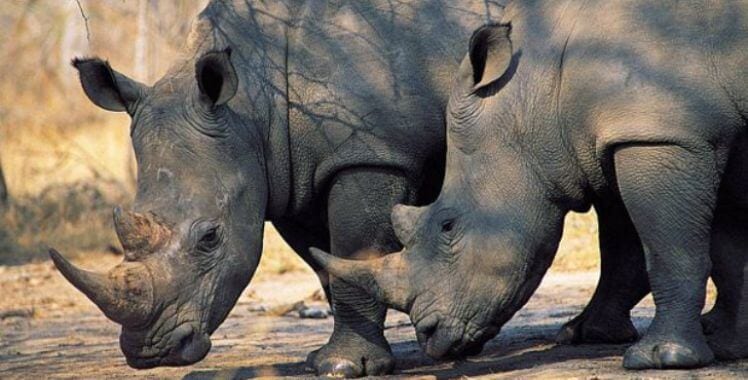Aardvark

Juvenile aardvark
Aardvarks live throughout Africa, s of the Sahara. Their proper noun comes from South Africa'southward Afrikaans linguistic communication and means 'earth pig'. Being nocturnal, they spend the hot African afternoons resting in their cool underground burrows, and nighttimes foraging in grasslands and forests for termites.
African bush-league elephant

Elephant close up
The African elephant (Loxodonta africana) is the largest and heaviest land animal in the world, weighing up to 6 tonnes. Their distinguishing features include the unique and dexterous elephant trunk, large ears that cool the trunk when flapped, and elongated incisors in the course of tusks. There are actually two species of African elephant – the African bush elephant and the smaller African forest elephant. Both are herbivores that live in large groups, whilst the African bush elephant is the larger of the two species, and typically the species referred to equally a member of the large five animals.
A bull elephant can be dangerous, equally can herds or mothers with young elephants. Keep your altitude from them, and if in a vehicle ensure that you have the means to drive abroad forwards – elephants tin run faster than a car can reverse. An elephant flapping its ears, boot upwardly dust and/or trumpeting is probably almost to accuse.
Group proper name:Herd
Size:Upward to iii.3 meters alpine, weighing vi,000kg.
Speed:Upwardly to twoscore km per hr.
Diet:Elephants are vegetarians, eating up to 160kg per day, fabricated up of savannah grasses, bushes, small plants, fruit, twigs, tree bark, and roots.
Range & Habitat:African Elephants are found beyond sub-Saharan Africa – from Mali in the north, through the central and west African forests, downwards to South Africa. They are adjustable animals, capable of surviving in many habitats, from lush wetlands to barren deserts.
All-time places to see African Elephant: Addo Elephant Park, South Africa,Chobe National Park,Republic of botswana,Etosha National Park, Namibia, Hwange National Park,Republic of zimbabwe, Southward Luangwa National Park, Zambia.
Caracal

Caracal stalking
Caracal (meaning 'black ears' in Turkish) are mutual beyond Africa, and also native to the Middle Due east, and parts of Asia and India. They are characterized by their stocky body on long legs, tufted ears, and uniform sandy colour. At 0.v meters tall they weigh in at simply 12 kg, and spectacular acrobats, able to leap 3 m into the air.
Cheetah

Cheetah walking in the sunset
Group name: Coalition.
Size:0.9 metres, weighing upward to 72kg.
Speed:With a maximum speed of 92 kilometers per hour, the cheetah isthe fastest state animal in the earth.
Nutrition: Cheetahs hunt small and medium-sized mammals such as hares, impalas, wildebeest calves, and gazelles, either on their ain or in small family groups.
Range & Habitat: Cheetahs are found in Eastern and Southern Africa (though are also establish in Iran and Afghanistan), generally confined to very small, fragmented habitats of savanna, dry and scrub forests and grasslands.
All-time places to come across cheetahs: Etosha National Park,Namibia,Kruger National Park, Due south Africa,Masai Mara National Reserve, Kenya.
Eland

The eland is one of the African savanna's well-nigh enduring savanna animals. The largest of the antelope family, the creature is remarkable for its striking coat and impressive, ox-like build. Elands brand a peculiar clicking audio that can be heard from a mile away, the source of which is a subject of some debate. Some believe it's produced by the eland's legs, with others believing information technology's the eland's spiral hooves that make the sound.
Where to see eland: The eland thrives in thegame parks ofKenya,Tanzania, Republic of zambia,Botswana, Republic of zimbabwe, andSouth Africa.
Giraffe

Giraffe mother with 2 young on the savanna
Perhaps the ultimate icon of the African savanna, the giraffe is an unmistakable land mammal known for its long neck and spotted coat. They were known by Arab prophets as the 'queen of the beasts' because of their delicate features and svelte poise.
With nine subspecies sharing its distinctive characteristics, this safari animal is the tallest in the world by some way. The giraffe'southward coat is characterised past dark blotches on lighter hair. With age, male giraffes may become darker, and while calves inherit spot patterns from their mothers, each giraffe has a unique glaze pattern that sets information technology apart. Information technology has a sharp sense of hearing and odor, another defense against predators, while it can close its nostrils during sandstorms and against ants.
Best places to see giraffe: Etosha National Park in Namibia, Kruger National Park in South Africa,Serengeti National Park in Tanzania,Masai Mara National Reserve in Kenya.
Grant'southward zebra

Zebras drinking on the savanna
Zebras are perhaps the most stylish of Africa's stars, with their characteristically stunning coats of black and white stripes. These distant relatives of the equus caballus are a frequent sight on any African safari and consist of iii different species.
There are many theories about why zebras are striped, and information technology seems that peradventure the about probable answer is that the stripes office as a way to deter biting insects like tsetse flies and mosquitos.
Plains zebras play a particularly interesting office in the ecosystem, as they are pioneer gazers, nibbling and feeding on the meridian-most layer of grass, thereby opening up the grassland for more than specialized grazers looking for the short grasses tucked below.
Best places to see zebra:Etosha National Park, Namibia, Makgadikgadi Pans in Botswana, Masai Mara in Kenya, Okavango Delta in Botswana, Samara Game Reserve in Due south Africa, Samburu National Reserve in Kenya, Serengeti National Park in Tanzania
Hartebeest

The hartebeest, is a large African antelope, also known equally a kongoni. With a camouflaged fawn-color, their most distinctive characteristics are an elongated snout and steeply sloping dorsum. Despite their strange looks, the hartebeest is i of the fastest animals on the savanna, reaching speeds of close to lxx kilometers per hr.
Impala

Impala jumping in lush green bushes
The impala is an animal that y'all shouldn't have too much problem spotting during your safari. The impala has a lovely red coat matched against a white underbelly, which might seem reminiscent of the springbuck, except not equally dramatic a contrast between the ii.
The impala is sexually dimorphic, which means that the males and females don't wait alike. Where males have horns, the females don't, and it's with these lyre-shaped horns that the males fight off their opponents and rivals. The curved arch ways the horns go interlocked during a skirmish, potentially saving the male impala from skull damage or serious wounds.
Jackal

Gold jackal standing in green grass
The jackal is a relatively small canid that is found predominantly in Africa, with some species residing in Southeastern Europe and Asia. The African jackal is known equally "Mbweha" in Swahili.
At first glance, the jackal looks similar a cantankerous betwixt a fox and a German language shepherd dog. This is because it has a small face up, delicate legs, fluffy tail, and ears that resemble those of a German shepherd.
Leopard

Leopard lying on a tree co-operative
Group proper name:Leap.
Size:ane meter high, weighing up to 100 kg.
Speed: 56 km per hour.
Nutrition:Leopards are opportunistic carnivores and chase a broad range of prey such asjackals, antelopes, gazelles, African monkeys, duiker, eland, impala,wildebeest and more than.
Range & Habitat: Leopards live in more places than any other big cat, and are comfortable in almost any habitat, including deserts, rainforests, woodlands, grassland savannas, mountain, scrub, and swamps. Leopards are 1 of the few big game species found outside national parks.
Best places to see leopards:Londolozi Game Reserve,South Africa,Moremi Game Reserve,Botswana, Samburu National Reserve,Kenya, Due south Luangwa National Park, Zambia.
Lion

Lioness scouts for prey on the savanna
Group proper noun: Pride.
Size:ane.2 meters, weighing upward to 225kg.
Speed:At a maximum speed of 80 kilometers per hour, the king of beasts is the 2d fastest state animal in Africa.
Diet:Lions are apex predators and more often than not hunt the larger animals in their surroundings – buffaloes, rhinos, zebras,giraffes, and antelopes.
Range & Habitat:Lions tend to prefer grassland, savanna, dumbo scrub, and open woodland. They are constitute across sub-Saharan Africa, and also in a pocket-sized office of north-eastward India.
Best places to meet Lion:Kgalagadi Transfrontier Park,South Africa,Kruger National Park, South Africa, Maasai Mara National Reserve,Kenya, Ngorongoro Conservation Area, Tanzania,Okavango Delta, Republic of botswana.
Ostrich
The common ostrich is the tallest and heaviest bird in the globe, with an average height of over ii meters (sometimes as alpine as 2.seven meters) and a weight of upwardly to 160 kg. At this size, the ostrich is, of course, a flightless bird, but tin outrun plenty of animals with its tiptop speed of 69 km per hr. Their long, powerful legs double upward as defensive weapons which pack a powerful boot to would-be predators. Fun ostrich fact – they are able to survive without h2o for days, generating water internally and extracting water from vegetation.
Rhinoceros

Two southern white rhinos
Rhinos are something yous just demand to come across to understand how impressive they really are. A rhino sighting is always special and equally you lot await in awe your eye will definitely skip a beat.
Once widespread through sub-Saharan Africa, the rhinoceros has been hunted to the brink of extinction and is probably the hardest of the big v to spot in the wild. There are ii species of rhinoceros in Africa – the black rhino (Diceros bicornis) and the white rhinoceros (Ceratotherium simum).
Whilst white rhinos have fabricated a comeback through conservation efforts across the continent, black rhinos are still very much i ofAfrica's endangered animals, and the hardest safari animate being to spot. The cardinal differences between the white and blackness rhino are non colour, but rather size, temperament, food preference, and oral fissure shape.
Best places to see Rhinoceros: Etosha National Park,Namibia,Hluhluwe–Imfolozi Park,South Africa, Lewa Wild fauna Conservancy,Kenya, Mkomazi National Park,Tanzania.
Spotted hyena

A hyena cub close up
Hyenas are unique and vital components of almost African ecosystems, both taking advantage of other animals' kills for easy meals and hunting themselves. The size of a hyena kill or scavenge is generally determined by the size of the hyena's clan, which tin run to dozens. They often hide actress food in watering holes, since nothing is wasted. Hyenas will eat every function of an fauna, including bones and hooves.
Hyenas tin can arrange to almost any habitat and are plant in grasslands, woodlands, savannas, forest edges, sub-deserts, and mountains.
Warthog

Warthog walking in long savanna grass
Warthogs are normally found in family groups, where they spend most of their time either looking for food or wallowing in the mud at waterholes. At night they shelter in burrows, entering tail first.
Warthogs have a wide distribution across sub-Saharan Africa, with a preference for open woodland and savannahs, and are not endangered.
Wild dog

Wild dog with a bloody face
African wild dogs alive in packs of around half dozen-twenty and are highly intelligent and sociable. One of the most fascinating sights is the bond they display before a hunt; the group begins mingling within the grouping, vocalising and touching each other, working each other up into a frenzy of excitement. Sadly, these animals are highly endangered
Best places to see wild dogs:Hluhluwe-Imfolozi Game Reserve in Southward Africa, Hwange National Park in Zimbabwe, Kruger National Park in South Africa, Niassa National Reserve in Mozambique, Kwando, Selinda & Linyanti in Botswana, Tswalu Private Biological reserve in South Africa.
Wildebeest

Huge herd of wildebeest meandering through the long xanthous grass plains in Tanzania's Serengeti
Wildebeest are primarily grazers, enjoying the grass, and the occasional shrub and herbs, living in herds of betwixt ten and many thousands. They're characterized by a long black mane and a beard of hair hanging from the throat and neck, along with their short curved horns, with males weighing upwardly to 250kg.
Their preferred habitat is open grasslands, with their renowned seasonal migration being an optimized survival strategy giving them access to and use of resources over huge areas, minimizing over-grazing during both wet and dry seasons.








































